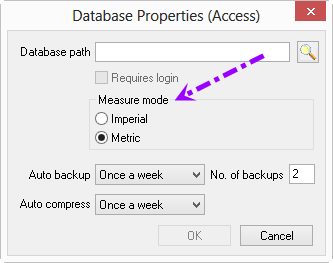
6.01.03 Units of Measurement (UOM)

Quick Bid can accommodate both Imperial and Metric Units of Measure (UOM) but not in the same database. When a new database is created, choose which measurement to use - all 'UOM' boxes are based on this setting.
The UOM is the base measurement used to define quantities throughout the database tables including Bid Reports. The UOM also controls the options available at the Calculation, Sizing and Pricing tabs. These measurements dictate the data required for the calculations. The UOM is a tag that always accompanies a quantity. If you are building a material record, the UOM will generally correspond with the UOM quoted by your supplier.
An Item can only hold a single UOM, therefore once the UOM is set to define material quantities, all labor values use the same UOM. For example, you may price wall covering by the LY, so the UOM would be set to LY. If Labor is attached to the same record, you must price the labor by LY. If you prefer labor priced by the SF rather than LY, just build a separate Labor-only record using SF as the UOM.
By default, databases are created in Imperial Measure Mode.
Available units of measure:
Imperial UOM
|
Système International (Metric) UOM
|
* The roofing industry works with a unit called a Square which equals 10' x 10' or 100 SF. There is no metric equivalent in the roofing industry and a Square is usually considered an Imperial-only unit. The metric equivalent of 1 SQ is 9.290304 SQ Meters.
To set a database to use Metric measurements, select Metric in the Database Properties (Access) dialog when creating the database.

All Bids created in this database will use Metric measurements.
Do not import Metric bids into an Imperial database or vice versa. If you receive a Metric Bid from another user, create a Metric database and import the Bid into that database (same goes for Imperial into a Metric database...)
When entering a quantity in any Imperial measurement box, the last two digits typed are always interpreted as inches and will always convert to feet. For example: 824 is interpreted as 8 feet, 24 inches and displays 10' 0", 10 is 10" and 1010 is 10' 10".
When entering a quantity in any Metric measurement box, the value is ALWAYS entered as millimeters. Example - to enter 5 meters into a measurement box, type "5000".